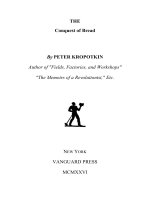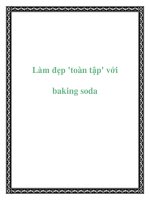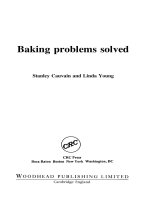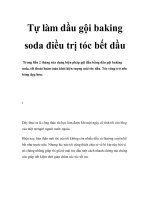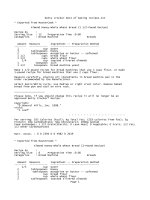baking artisan bread - hitz
Bạn đang xem bản rút gọn của tài liệu. Xem và tải ngay bản đầy đủ của tài liệu tại đây (12.09 MB, 227 trang )
Baking Artisan Bread
10 EXPERT FORMULAS FOR
BAKING BETTER BREAD AT HOME
Ciril Hitz
PHOTOGRAPHY BY
RON MANVILLE
BEVERLY MASSACHUSETTS
Dedication
This book is dedicated to my children, Kira and Cailen.
Their unconditional love is more gratifying than the
best bread I have ever baked.
Contents
Foreword by Jeffrey Hamelman.
Introduction
PART ONE:
Basics
Chapter One:
Ingredients
Flour
Yeast
Water
Salt
Chapter Two:
Equipment and Techniques
Scales and Measuring
Mixers and Mixing
Three Mixing Styles
Other Tools
Ovens
Pre-Ferment Basics
Shaping Basics
PART TWO:
Baking
Chapter Three:
The 10 Steps of Baking.
Chapter Four:
The Bread Formulas
Baguette Dough
Épi
Scroll
Breadsticks
Ciabatta Dough
Twist Sticks
Focaccia
Whole Wheat Dough
Round Rolls
Savory Pizzalets
Pita Bread
Pane Francese
Fougasse
Stamped Rolls
Pizza Dough
Dessert Pizzas
Easy Rolls
Bagel Dough
Bagel Bites and Logs
Bialys
Pain de Mie
Cinnamon Spice Swirl Bread
Raisin Rolls
Picnic Rolls
Challah Dough
Orange Aniseed Loaf
Knotted Rolls
Brioche Dough
Sticky Bun Coffee Cake
Sweet Filled Brioche
Croissant Dough
Pain au Chocolat
Hazelnut Snail
Fruit Danish
Monkey Bread Deluxe
Chapter Five:
Extras
Bread Crumbs
Croutons
Bagel Chips
Baguette à la Pizza
Bread Salad
French Toast
Bread Pudding
Washes and Glazes
Sweet Embellishments
Savory Inspirations
Appendix
Troubleshooting
Charts and Conversions
Ingredients, Tools, and Equipment
Education and Organizations
Recommended Reading
Glossary
Index
Acknowledgments
About the Author
About the Photographer
FOREWORD
by Jeffrey Hamelman
THE WORLD DOESN’T SEEM TO BE SLOWING DOWN; at least, the human beings who
inhabit it don’t. More work, more stress, more demands on our time; many
perhaps even feel disconnected from fundamental human links, as if
something within us is cracked, almost broken. And so it seems ironic to
see the great resurgence in bread baking in so many parts of the world.
After all, with so much tugging at us, how can we find the time to bake for
ourselves, for our family and friends?
We are emotive creatures, and we require fulfillment, both tactile and
creative. When we enter the realm of bread, we find that the chatter of life
slips away, that our hands regain their tender partnership with the
breathing dough. We reunite with an ineffable and elemental connection
that has been part of our shared heritage for thousands of years. When
bread comes fragrant from our ovens, we are rewarded with a most
marvelous experience of creation.
Baking Artisan Bread is a friendly book, written by a friend of good
bread. Ciril Hitz is an outstanding teacher, and he has distilled his years as
an instructor into a book that is both good and earnest, one that will make it
easy for readers to enter the kitchen with confidence. Ciril rolls up his
sleeves from the first page and has us pulling out the flour. His approach
will be especially helpful to those new to baking. The recipes he offers are
sound and solid, and the variations he gives for each of them enable us to
really expand our repertoire. It’s particularly valuable to be able to make
good bread, a tasty savory item, and even a dessert from just one dough—
a small increase in time and ingredients results in a large increase in
products and flavors.
On their own, Ron Manville’s photographs are absolutely delightful; when
coupled with Ciril’s discussions of themes such as shaping and
troubleshooting, there is a synergy that vividly elucidates the topic. Habits,
either good ones or bad, feel natural, and the combination of clear text and
skilled photography will prove especially helpful to new bakers who are
learning the basics, those whose habits have yet to be fully formed. Ciril
has opened a door into a room full of many possibilities—your kitchen. His
hope, which I fully share, is that you take the time to explore that room and
expand your experience and your love of baking fine breads.
Jeffrey Hamelman is an employee-owner of the King Arthur Flour
Company in Norwich, Vermont. He is the director of the King Arthur
Bakery, and instructs the professional classes offered at the King Arthur
Baking Education Center. He is the author of Bread: A Baker’s Book of
Techniques and Recipes.
INTRODUCTION
The Quest for Artisan Bread
FLOUR, WATER, SALT, AND YEAST—these four simple ingredients when
combined create the magic that is bread. Baking bread is a time-honored
tradition honed over more than six thousand years. The craft is a truly
sensory experience: the warmth of the dough in your hands, the aromas
lingering in the air during baking, the crackling of the crust as it cools, the
complex and seductive flavors on your tongue. Yet for some, the process of
making bread strikes fear in their hearts. I hope to change that.
In the world of bread bakers and grammarians alike, there has been
much debate about the usage of the word artisan. Artisan is actually a
noun that refers to a skilled worker or craftsman, but due to the ebbs and
flows of popular usage, it is applied as an adjective for carefully
handcrafted food and beverages, such as cheese, wine, chocolate, and, of
course, bread. The romance associated with something handmade,
especially in our hustle-bustle world, entices people to seek out artisan
products. Unfortunately, the word artisan is sometimes liberally used and
abused in the marketing campaigns of larger bakeries and corporations,
diluting its meaning.
As for defining artisan, if you asked fifty artisan bakers to describe
exactly what being an artisan baker means, fifty different styles would be
conjured. My personal definition of artisan bread is handmade bread that
is crafted using quality, natural ingredients and does not include any added
chemicals or artificial ingredients. Anyone who considers himself an
artisan baker has the responsibility of aiming to reclaim the true origins of
the word through experience and education.
The good news is that the quest to make good bread by hand is not one
of endless toil. Technology is the baker’s friend, and mixers and other
equipment are welcome time-savers. It is my opinion that a baker can craft
“handmade” bread while taking advantage of helpful technology. Time is
also a critical ingredient that cannot be shortchanged.
Being organized and rational about the baking process will aid the
aspiring artisan baker. When I competed in my first international baking
competition, I streamlined my baking style to maximize my performance
and products within a limited amount of time. As a result, I’ve learned to
work through geometric expansion, increasing the number of different
breads that can be made from one dough.
With these artisan formulas, you can create a multitude of ide of
fantastic, flavorful breads for any occasion.
My premise is simple: If you are going to invest the ingredients, time,
and energy in making a dough from scratch, then why not maximize this
effort to create more bread? After all, isn’t time one of our most precious
resources? With just small adjustments or additions, each of the ten bread
formulas in Baking Artisan Bread generates a new bread form. A baguette
dough yields a bouquet of breadsticks, a buttery brioche dough elegantly
becomes a fruit danish, and so on, through more than thirty mouthwatering
variations.
Baking Artisan Bread provides clear definitions, thorough explanations,
and logical steps for creating wonderful bread at home with professional-
quality results. The main ingredients are introduced and pored over in
chapter 1, while chapter 2 introduces the basic necessary equipment,
along with some essential techniques and concepts. These two chapters
of part 1 pave the way for part 2, beginning with chapter 3, an overview of
the ten steps of baking that provides the organizational thrust of each
formula. This chapter introduces what happens at each stage of the dough
development and why—what mixing really is, why a dough needs to rest,
and when it is ready to bake. It is followed by the formulas and variations,
presented in lush, step-by-step photos. And as a bonus, you can refer to
the instructional segments in the accompanying DVD to view basics, such
as mixing and shaping, explained in action. If by then you haven’t become
a disciple of bread baking, it is my hope that with time and practice, you
will revel in its joys as much as I do.
Happy baking!
Basics
BREAD BAKING is a delicate dance between the simple and the complex. On
one hand, nothing could be more straightforward: just combining flour,
water, salt, and yeast yields a dough that with the baker’s touch magically
transforms into a crusty baguette or a hearty loaf. On the other hand, the
science behind the “magic” is incredibly complicated, and research
reveals the markedly complicated process that baking actually is.
Don’t let the complexities of the baking process intimidate you, though.
Knowledge is power and, in the case of bread baking, an overview of the
components and processes is all you need to start your journey. In the
following chapters, the roles of the ingredients, equipment, and techniques
are explained and expounded upon. The most important information is
extracted and reduced to readily accessible and easily understood core
concepts. Armed with these essentials, you can move confidently into the
kitchen and let the baking begin!
CHAPTER ONE
Ingredients
THE MAIN INGREDIENTS of bread are strikingly simple: flour, water, salt, and
yeast. Each one has a precise role to play in creating a dough that has the
qualities desired in the type of bread.
Using the highest quality ingredients you can afford is one of the keys to
successful baking. Creating the best product possible starts with the best
possible ingredients. These are, after all, the foundation of any formula,
and sacrifices or compromises made at this level will definitely have an
impact on the bread. That being said, you should not take out a second
mortgage to get through your shopping list. One of the great things about
bread baking is that the basics are very common and usually do not involve
extra trips to specialty foods stores.
For some, though, shopping is half the fun. If you are someone who
pores over kitchen product catalogs, or you incessantly comb the Internet
for new and interesting sources of little-known ingredients, then by all
means, experiment! Experimenting with different brands of flour or yeast
will be part of your education as a baker. As you gain experience, you will
develop your own baking identity and personal preferences and will come
to recognize the qualities of ingredients (and their edible results) that are
most important. Baking bread is an art form, one that is open to
interpretation and individualizing. And so while each formula has certain
standards to be met, bakers bring their own set of unique tools and ideas,
ready to make their individual mark on their bread.
The next few pages introduce and explore the four basic ingredients
used to make bread. While the main points of each ingredient are
simplified, some are more complex than others. Flour, for example, has
many different characteristics that a baker must take into consideration
when choosing one. Water, on the other hand, does not. As you read about
each ingredient, you will become more aware of the choices available to
you and what kind of issues may affect your purchases and baking
decisions.
Flour
Most bread consumed in the United States is made from wheat flour.
Wheat is considered a cereal grain, along with rice, corn, oats, and rye.
What makes wheat the grain of choice for bread baking? One of the
primary factors is the presence of certain proteins with gluten-forming
properties. When mixed with water and developed into dough, the wheat
flour is given life, and the gluten protein creates a structure much like an
intricate web. The interlaced gluten strands capture the gases that have
been created by the yeast and are flexible enough to allow the dough to
“rise,” expanding in size.
HOW FLOUR IS MADE
Flour is made by grinding wheat kernels, also known as wheat berries. A
wheat kernel is the seed of the wheat plant and has three main parts: the
bran, the endosperm, and the germ. The bran is the outer protective layer
of the kernel and is high in insoluble fiber, minerals, and vitamin B.
Underneath the bran lies the endosperm, which makes up the bulk of the
kernel. It contains mostly starch and is the whitest part of the kernel. It also
contains the proteins that form the gluten matrix, a necessary component of
a bread’s crumb structure. Most refined flour comes from this part of the
kernel. The germ, in the right conditions, will sprout, or germinate, and
allow the seed to grow into a new plant. This embryo is composed of
essential oils and vitamin E.
A variety of flours and wheat, clockwise: pastry flour, bread flour, high-
gluten flour, white whole wheat flour, cracked wheat; middle: whole wheat
berries
Wheat is made into flour by milling. The wheat kernel is crushed into
progressively smaller particles, and depending on the type of flour, parts of
the kernel are removed by sifting. The degree of separation that takes
place is called the extraction rate. A flour that uses the entire wheat kernel
is said to have a 100 percent extraction rate, meaning the entire kernel
was ground into flour and nothing was removed, resulting in a 100 percent
whole wheat flour. Most conventional artisan bread flours have an
extraction rate of 73 to 76 percent. As a rule, flour with a higher extraction
rate contains more minerals and is more nutritious than flour with a lower
rate.
By law, supplements can be added to the flour to replace any vitamins
and minerals removed during the milling process. This, however, does not
replace the nutritional benefit of whole-grain flour.
Once flour is milled, it needs time to mature. This aging process is
critical to the performance of the flour in the baking cycle. Although unaged
flour has more available nutrients, without proper aging flour tends to have
a sluggish fermentation cycle and becomes harder to shape. Ideally, flour
will have a minimum of 3 to 4 weeks to mature, which means storing the
flour in large silos and taking up precious space. To mitigate the high costs
of properly maturing flour, some suppliers artificially age the flour with
gases and oxidizing agents such as potassium bromate. These agents
have harmful side effects on both humans and the environment. The
nutritional label on the flour is a good source of information about the
manufacturers’ aging processes. (It is advisable to choose unbleached
and unbromated flour.)
FLOUR SPECIFICATIONS
When bakers get together, they like to talk about their flour in very technical
terms. For the home baker, it is good to be aware that these specifications
exist, but it is not necessary to be bogged down with or intimidated by this
data, either. There are many different types of wheat: from hard to soft,
from summer to winter, and from red to white. Each type of wheat has its
own characteristics, and different flours are often blended to meet a certain
specification. The bread flour preferred for the recipes in this book should
be derived from a hard winter wheat. This type of wheat has a protein
content between 11 and 14 percent, with the most ideal protein content for
artisan bread baking being 11.5 to 11.7 percent. When held in the hand
and squeezed, this flour does not lump up and does not need to be sifted.
More Minerals = BETTER FERMENTATION
Just like the human body, yeast is a living organism that thrives when
it is fed a good, healthy diet. The more minerals retained in the flour
after milling, the more beneficial it is to the fermentation process.
The nutrients present are processed by the yeast and result in a
healthier, more robust culture.
STORING FLOUR
Flour should be stored in an airtight container and away from heat. It is
best to buy flour in quantities that will last around 2 to 3 months. Flour can
also be wrapped tightly in plastic wrap and stored in the freezer for up to 1
year. Special consideration should be taken when storing whole wheat
flour. The natural oils in the wheat germ make this flour more sensitive to
heat than regular bread flour or all-purpose flour is. It is best to store this
flour in an airtight container in the refrigerator, especially during warm
spells, to prevent the flour from becoming rancid.
Yeast
Yeast is a single-cell organism that feeds from simple sugars naturally
present in flour in a process called fermentation. In the presence of warmth
(ideally 75°F to 78°F [24°C to 26°C]) and moisture, this process takes
place and accelerates with higher temperatures. The artisan bread baker
strives to enhance the flavor and aroma of the bread by controlling this
process of fermentation.
VARIETIES OF BAKING YEAST
There are innumerable types of yeast, but two are specifically used for
fermenting bread: the wild Candida milleri and the manufactured
Saccharomyces cerevsiae. Sourdough breads are made with the wild
yeast, and the baker maintains the yeast’s life cycle by regularly feeding
the sourdough culture, also known as a starter. The care and cultivation of
starters and their use in baking is more complicated and challenging than
the scope of this book, and therefore none of the formulas presented in this
book are for sourdough breads. Instead, these formulas utilize
manufactured yeast that is produced in a lab facility under very tight and
strict conditions.
Commercial yeast is available in three main forms:
Active Dry Yeast
Until recently, active dry yeast was practically the only yeast one could
buy in a supermarket. Usually sold in packaged perforated envelopes,
active dry yeast needs to be rehydrated properly before use. The yeast is
allowed to dissolve for about 5 minutes in 100°F (38°C) liquid (water in
most cases) before being added to the final dough. If the formula calls for
water to be at a cooler temperature when it is added to the final dough, the
liquid yeast solution should be cooled before the mixing can commence.
From top to bottom: active dry, instant, and fresh yeast
FERMENTATION 101
The complicated process of fermentation, reduced to bare bones, goes
something like this: The starches present in flour are broken down into
simple sugars, which then act as food for the yeast. The yeast “eats” the
sugar and expels carbon dioxide and alcohol in the process. This
feeding cycle continues until the yeast runs out of sugar, or until the
bread is baked. Once the internal temperature of 138°F (59°C) is
reached, known to bakers as the “thermal death point,” all fermentation
ceases. One can almost picture the tiny molecules of carbon dioxide
gas trying to make their way out of the dough, but the gluten matrix (that
weblike structure of gluten forming proteins) traps the gas, creating a
balloon around the carbon dioxide. This gives the dough the desired
rising characteristic typical for yeasted breads. (The gluten-forming
process is explored at length in chapter 2, pages 29–30.) The alcohol
dissipates during the baking process.
Instant Yeast
Sometimes marketed by manufacturers as “bread machine yeast,” instant
yeast is usually sold in a small vacuum-packed brick and is available in
many larger supermarkets and through catalog and Internet sources. It has
a long shelf life and can be stored unopened without refrigeration for up to
a year. Once opened, it should be stored in an airtight container in the
refrigerator. Although the manufacturers recommend that it be used within
a month, it can usually be stored much longer. The beauty of instant yeast
is that it can be added directly to the dry ingredients of the final dough
before mixing. While it may be a bit pricier than fresh yeast, the
dependability of its performance far outweighs the additional cost.
Instant yeast is also available in an osmotolerant form for use in
sweeter, enriched doughs. The abundant sugar present in these doughs
draws the water away from the yeast, making it a very inhospitable
environment for regular instant yeast to do its job. The osmotolerant form
has literally been engineered to perform under these harsh conditions and
is therefore ideal to use in sweet and enriched yeasted doughs, such as
brioche (see page 124).
Fresh Baker’s Yeast
Fresh, or compressed, yeast contains 70 percent water. It is tan in color
and should break cleanly when touched. It should have a pleasant, yeasty
odor to it. Fresh yeast can be purchased at some grocery stores and
through catalog and Internet sources and should be stored in an airtight
container in the refrigerator, where it has a shelf life of 3 weeks. A
drawback of fresh yeast for home bakers is that one can never be quite
certain if the yeast is actually fresh enough, especially if it is purchased
from a source that does not sell much on a regular basis. Even most
experienced, professional bakers tend to prefer the more consistent
quality and performance of instant yeast.
The formulas in this book specify instant yeast exclusively, as it is a
favorite ingredient both at home and in the bakeshop. If you would
like to experiment with either active dry or fresh yeast, please refer to
the yeast conversion chart in the appendix (page 165).
Water
When it first comes in contact with flour, water swells the starches and
awakens the dormant gluten-forming proteins. Fermentation could not take
place without water and, to ferment properly, the dough needs to achieve a
certain temperature. The temperature of the flour and any pre-ferments are
dictated by their surroundings and are hard to change. The temperature of
the water is the only variable that can easily be adjusted before it is added
to the final dough to help ensure that it reaches the necessary temperature
range.
HYDRATION RATES of Dough
Water is the main hydrating factor in dough, although other liquids are
frequently included, such as milk, eggs, and oils. When bakers talk
about the hydration of doughs, they are referring to the relationship
between the liquids as they compare to the flour. For example, if a
dough has 1,000 grams of flour and 750 grams of liquid, it has a
hydration rate of 75 percent. A dough with a high hydration will be wet
and sticky, whereas a dough with a low hydration will be stiffer. If a
dough has too much liquid (more than 80 percent hydration), it will be
too wet to comfortably handle. On the flip side, a dough must have a
minimum hydration of 50 percent or the dough will not come together as
a unified mass.


